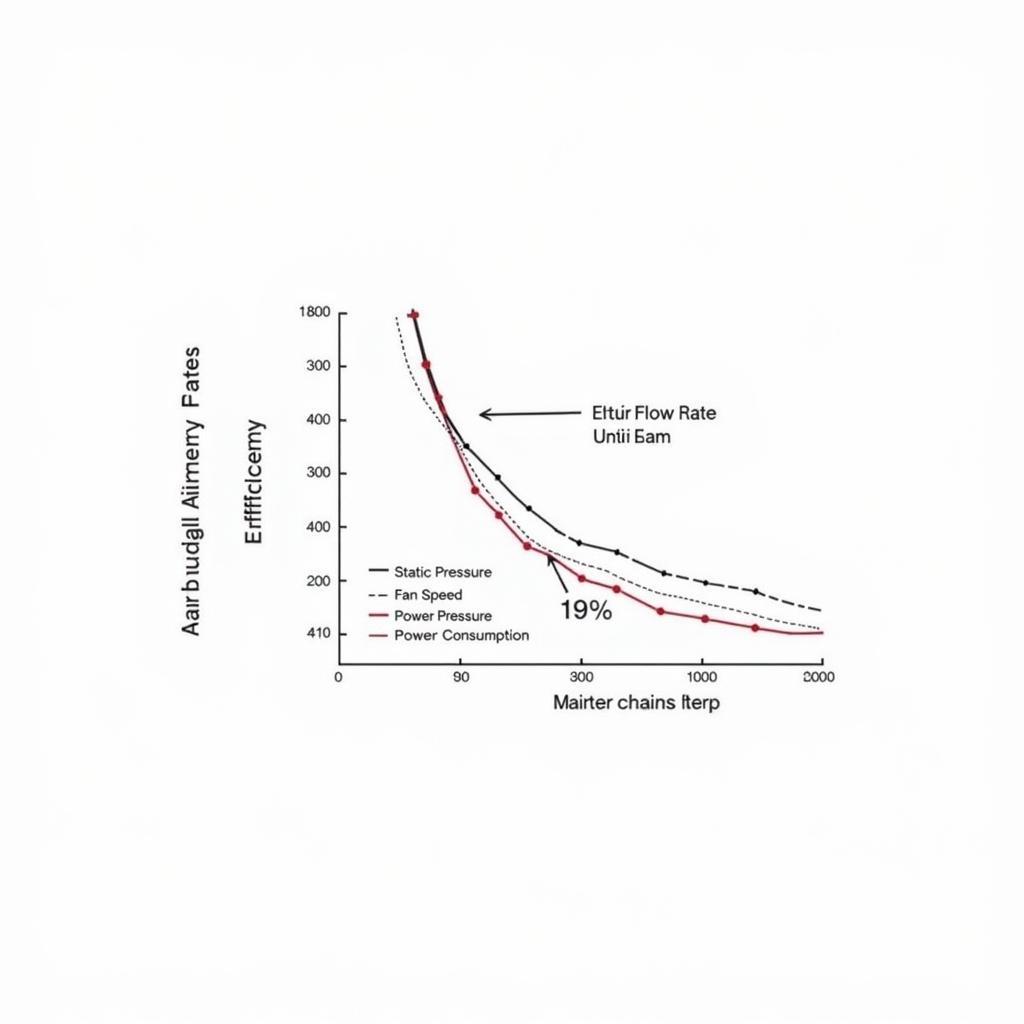The Centrifugal Fan Efficiency Curve is a critical tool for anyone working with these essential pieces of equipment. It provides a visual representation of how efficiently a centrifugal fan operates across various airflow rates. By understanding this curve, engineers and technicians can optimize fan selection, predict performance, and troubleshoot potential issues.
What Does a Centrifugal Fan Efficiency Curve Tell Us?
 Example of a Centrifugal Fan Efficiency Curve
Example of a Centrifugal Fan Efficiency Curve
A centrifugal fan efficiency curve graphs the relationship between a fan’s airflow and its efficiency. Key points on the curve include:
- Peak Efficiency: This point represents the highest efficiency the fan can achieve. It’s the optimal operating point for energy savings and performance.
- Operating Range: This is the range of airflow rates where the fan operates efficiently, typically within 80% of peak efficiency.
- Shut-off Point: This is the airflow rate at which the fan is completely blocked, and no air moves.
- Free Delivery: This is the airflow rate when the fan operates against no static pressure.
Factors Influencing the Centrifugal Fan Efficiency Curve
Several factors can impact the shape and position of the efficiency curve, including:
- Fan Design: Impeller size, blade shape, and housing design all play a role in determining the fan’s efficiency characteristics.
- System Resistance: The ductwork, dampers, and other components in the system create resistance that affects airflow and efficiency.
- Air Density: Changes in air temperature and altitude can affect air density, which in turn influences fan performance.
Utilizing the Centrifugal Fan Efficiency Curve
Understanding the centrifugal fan efficiency curve is crucial for:
- Fan Selection: By comparing the efficiency curves of different fans, engineers can choose the most efficient model for a specific application.
- System Optimization: Analyzing the curve helps identify potential areas for improvement in the system, such as reducing ductwork resistance.
- Troubleshooting: Changes in the curve’s shape or position can indicate problems with the fan or the system, aiding in faster diagnosis and repair.
Practical Applications of the Centrifugal Fan Efficiency Curve
Let’s look at some practical examples of how the efficiency curve is utilized:
- HVAC Systems: In heating, ventilation, and air conditioning systems, the curve helps select fans that deliver the required airflow while minimizing energy consumption.
- Industrial Processes: In industrial settings, fans are used for various processes, such as material handling and exhaust ventilation. The efficiency curve ensures optimal fan operation for these applications.
- Data Centers: Data centers require significant cooling, and centrifugal fans are often used to provide airflow. Selecting fans with high peak efficiency points is essential for energy efficiency in these environments.
Interpreting Changes in the Efficiency Curve
Over time, a centrifugal fan’s efficiency curve may shift due to factors like:
- Wear and Tear: As components age, efficiency can decrease.
- Fouling: Dirt and debris buildup on the impeller or housing can obstruct airflow, reducing efficiency.
- Changes in System Resistance: Modifications to the ductwork or other system components can alter the resistance and impact the curve.
Regular monitoring of the efficiency curve allows for proactive maintenance and adjustments to ensure continued optimal performance.
Conclusion
The centrifugal fan efficiency curve is an indispensable tool for understanding, optimizing, and troubleshooting these essential pieces of equipment. By comprehending the information it presents, engineers and technicians can make informed decisions regarding fan selection, system design, and maintenance to achieve energy efficiency and reliable operation.
FAQs
1. What is the typical efficiency range for a centrifugal fan?
Centrifugal fans typically operate within an efficiency range of 50% to 85%, with some high-efficiency models exceeding 90%.
2. How often should I check my fan’s efficiency curve?
It’s recommended to check the efficiency curve at least annually or whenever you notice a significant change in fan performance.
3. Can I improve my fan’s efficiency?
Yes, you can improve efficiency by cleaning the impeller and housing, ensuring proper belt tension (if applicable), and optimizing system ductwork.
4. What is the difference between static pressure and airflow in the context of the efficiency curve?
Static pressure is the resistance the fan has to overcome to move air, while airflow is the volume of air moved per unit of time. The efficiency curve shows how these two factors relate to the fan’s efficiency.
5. Where can I find the efficiency curve for my specific fan?
The efficiency curve is usually provided in the fan’s manufacturer documentation or specifications.
For further information on related topics, you can explore our articles on blower vs fan static pressure and centrifugal fans and blowers. We also have a detailed guide on centrifugal fan installation that you might find useful.
Do you have more questions or need assistance with centrifugal fans? Contact us at Phone Number: 0903426737, Email: fansbongda@gmail.com or visit us at Address: Group 9, Area 6, Gieng Day Ward, Ha Long City, Gieng Day, Ha Long, Quang Ninh, Vietnam. Our dedicated customer support team is available 24/7 to help you.


